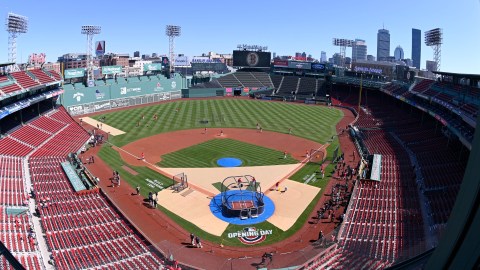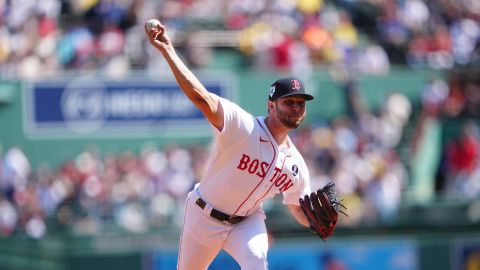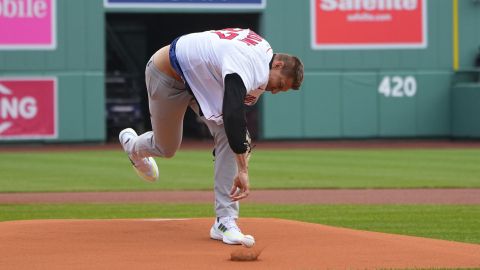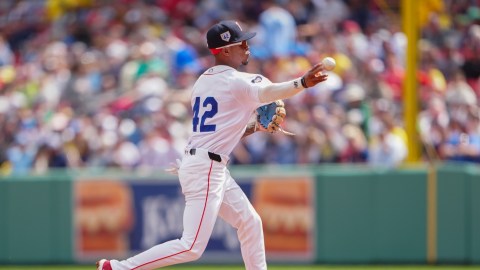 It’s the final mailbag of the regular season. Let that sink in for a minute.
It’s the final mailbag of the regular season. Let that sink in for a minute.
It seems like just yesterday we were discussing whether Jackie Bradley Jr. should crack Boston’s Opening Day roster and if Joel Hanrahan or Andrew Bailey was the right guy for the Red Sox’ ninth-inning duties. Oh, how things have changed.
Fortunately for Red Sox fans, October will bring more baseball. The Red Sox have locked up the American League East, and their focus is now on securing home-field advantage throughout the postseason. Oakland is currently nipping at Boston’s heels in the AL standings, but the Red Sox control their own destiny over the final week of the regular season.
The Red Sox have been baseball’s most consistent team in 2013. They look poised to make a deep playoff run, which is amazing considering where the club stood in 2012.
The Red Sox’ remarkable turnaround is at the heart of this week’s mailbag. Read on to see what else was signed, sealed and delivered.
Does Koji Uehara deserve the Red Sox 10th Player Award?
–Andy, Stoughton, Mass.
Yes, he does.
I’ve given this some thought lately — mainly because my father calls me to debate it every two or three days — and Koji Uehara seems like a slam dunk, despite there being a case for at least three other players.
For me, it came down to Uehara, Daniel Nava, John Lackey and Mike Carp.
Nava, in my opinion, is Uehara’s biggest competition in terms of the 10th Player Award. Nava has certainly “gone above and beyond expectations,” and he is still performing at a high level with the playoffs approaching. Entering Tuesday’s game in Colorado, Nava’s .381 on-base percentage is second only to Mike Trout’s .432 among American League outfielders. Nava ranks fourth in average (.297) and third in OPS (.819) among AL outfielders. No one saw that coming, and when you factor in Nava’s versatility, voting for him would have been totally understandable.
Lackey, meanwhile, has enjoyed a renaissance season after missing all of 2012 because of Tommy John surgery. There were some out there who thought that Lackey might be able to rebound, but even the biggest optimist probably didn’t envision the 34-year-old being Boston’s most consistent starter for much of the season.
And then there’s Carp, who actually fits the 10th player criteria in the traditional sense. He’s been a major force off the bench this season after being designated for assignment by the Mariners and later traded to Boston during spring training. You could argue that he deserves even more playing time and that his bench prowess makes him a true “10th player.”
Uehara’s remarkable 2013 involves much more than the element of surprise, though. While everyone on the Red Sox’ roster — including the three names mentioned above — has played a big role in Boston’s success, Uehara has been a life-saver. The Red Sox started hot out of the gate, but there was a point when it looked like their closer situation would ultimately derail their bid for an AL East title. Uehara, who had already been lights out in a setup role, not only stepped in and added stability to the ninth inning, but he’s also been arguably the best closer in baseball — right up there with Atlanta’s Craig Kimbrel.
Uehara might even be the Red Sox’ MVP this season. Closers are often overvalued, but there’s no overstating his importance in helping Boston remain MLB’s most consistent team. His numbers have been better than those posted by Jonathan Papelbon during his best years in Boston, and John Farrell has a tremendous amount of confidence in the 38-year-old.
This is one of those instances when you wish everyone could get a trophy. Maybe they’ll share a bigger one at the end of the year.
What is your take on the Red Sox signing another Japanese star pitcher? It seems like they’ve been gun-shy since Dice-K. Also, how about Cuban defectors?
–Jim, Denver
You’re right, Jim. It seems like the Red Sox have been a bit “gun-shy” — as you put it — when it comes to dipping into the Japanese market via the posting system. I think it’s simply a matter of timing, though.
The biggest star to come out of Japan since Daisuke Matsuzaka is Yu Darvish, and the Red Sox weren’t really in a position at the time to make such a sizable financial commitment. The Rangers spent more than $111 million to sign Darvish — between the posting fee and the pitcher’s salary — back in January 2012. Boston still had Carl Crawford and Adrian Gonzalez on the books, so the organization would have been spreading itself thin while taking a big gamble.
That being said, I don’t think the Dice-K failure will discourage the Red Sox too much from going after another Japanese hurler if they deem him to be a good fit. Boston’s reported interest in Masahiro Tanaka should be enough to prove that the organization is open to the idea of diving back into those waters. I would be surprised, however, if the Red Sox made a Dice-K-sized commitment — in terms of dollars and years — because the front office’s approach has changed drastically of late. Deals that exceed three years in length have become the exception rather than the norm.
In the case of Cuban defectors, I’d expect the Red Sox to take a similar approach. They’re not going to alter how they approach free agency, but they’ll be aggressive in doing their due diligence.
As I understand it, the Red Sox matched their high for single-game home runs (eight) versus the Tigers on Sept. 4. When had they accomplished that feat before?
–Bill Laudani, Coral Gables, Fla.
The Red Sox also hit eight home runs back on July 4, 1977, against the Blue Jays at Fenway Park. Fred Lynn (two), George Scott (two), Jim Rice, Butch Hobson, Bernie Carbo and Carl Yastrzemski went deep in that game.
Amazingly, the Red Sox only scored nine runs during that 1977 contest, as only one of the blasts came with a runner on base.
The Red Sox are up one game on the Athletics in the loss column. If they finish tied, who gets the No. 1 seed?
–Charlie, Winter Springs, Fla.
The Red Sox enter Tuesday’s action with a one-game lead over the Athletics. The first tiebreaker, if the two teams finished tied for the best record in the American League, would be based on head-to-head matchups. But since Boston and Oakland split their six games this season, the No. 1 seed would be determined by how each team fared against opponents within its own division. (In other words, the A’s record against AL West teams versus the Red Sox’ record against AL East teams.)
Entering Tuesday’s action, the Red Sox own a 43-30 record (.589 winning percentage) against the AL East. The A’s hold a 42-29 record (.592 winning percentage) against the AL West. The Red Sox finish the season with three games against the Orioles, and all five of the A’s remaining games are against AL West opponents (Angels and Mariners).
If the Red Sox and A’s end up with the same record and same intradivison record, which is still possible, they’ll move to another tiebreaker. The third tiebreaker is based on who has the better record in American League games in the second half of the season. The Red Sox enter Tuesday’s action with a 31-20 record (.608) in such games, while the A’s are 37-22 (.627) in such games.
Things could ultimately get complicated. The Red Sox currently control their own destiny, though.
What is the best part of the Red Sox’ turnaround?
–Joseph, Whitman
I’m not really sure how to answer this question. The whole winning thing seems to be what sports fans care about most, so I guess that’d be my short answer — although just seeing Red Sox fans get behind a likeable team once again after last year’s disaster is fun to watch.
I’m especially fascinated with how this whole thing came together, though. The Red Sox completely changed course in a matter of months, and Ben Cherington’s vision has been a breath of fresh air.
We’re in the midst of an interesting era, as there’s this ongoing clash between sabermetricians and baseball traditionalists. Baseball has and always will be a numbers game, but the development and implementation of new statistical analysis has caused a rift between advocates of the new quantitative data and those who would rather use the eyeball test than rely on a complex set of numbers. Last season’s Mike Trout–Miguel Cabrera MVP debate showed just how deep the rift runs, and, while fascinating, the whole thing was really quite annoying.
I never understood the beef between the “numbers guys” and those who have a more “old school” outlook. It’s almost like we, as baseball fans, are expected to take sides. But why? It’s not as if the two are mutually exclusive. It’s OK to mix and match. It’s not against the law to go after one player based on his WAR while pursuing another player because of things that can’t be quantified, like intangibles, personality and clubhouse leadership.
There’s a ton of value in the amount of quantitative data available, and it should absolutely be an important part of a team’s research on a given player. But there’s still a human element to sports. Building a successful team requires finding the right balance, and Cherington has struck that balance perfectly.
Do you think that John Farrell could win Manager of the Year?
–Alex, Nashua, N.H.
He gets my vote.
Terry Francona has done an excellent job in his first season in Cleveland, Bob Melvin (who won the award in 2012) keeps rolling in Oakland and Joe Girardi had an outside shot until the Yankees completely fell out of contention. But the Red Sox’ amazing turnaround starts with Ben Cherington and John Farrell.
Farrell has made a few questionable in-game decisions this season. Given his overall body of work, though, it’ll be surprising if he doesn’t take home the hardware.
Have a question for Ricky Doyle? Send it to him via Twitter at @TheRickyDoyle or send it here.




